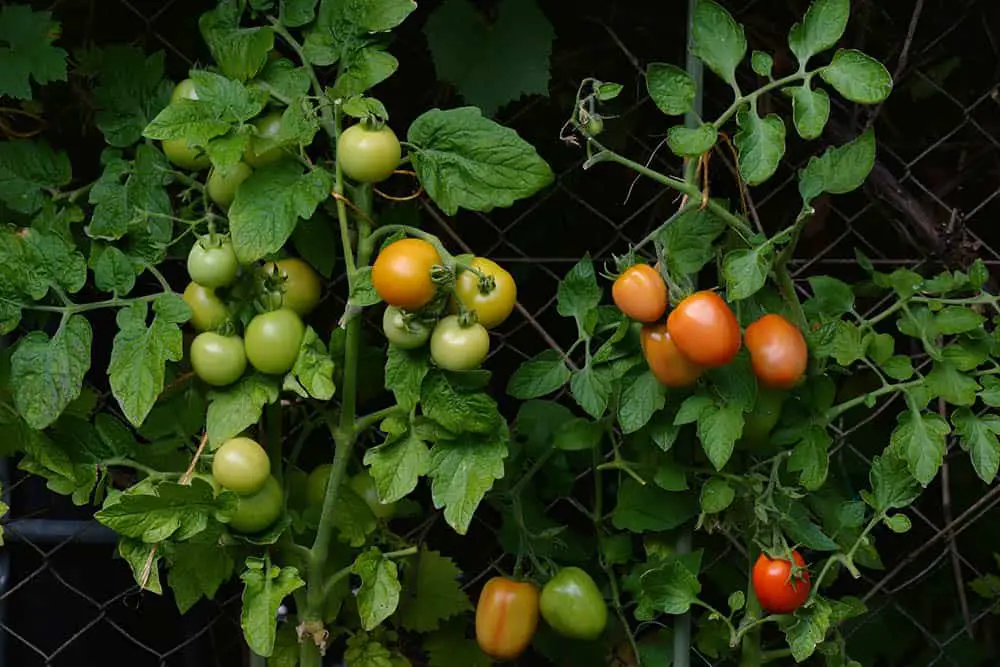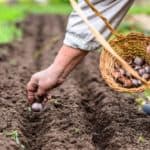The humble tomato (Solanum Lycopersicum) is one of the most popular and widely grown fruits worldwide.
It’s estimated that up to 93% of gardeners in the U.S. grow tomatoes in their yards. In its many forms, including condiments, the tomato is consumed in enormous quantities each year, with the average American consuming about 23 lbs of tomatoes annually.

A member of the Nightshade family, the tomato is technically a berry. This wonderful fruit is a proven antioxidant and has been shown to be effective against certain cancers and improve heart health.
But while it’s clear that tomatoes are beneficial to us, what can we do as gardeners to help our tomatoes to grow? We will be answering this question in today’s article, as well as questions relating to the tomato’s growth patterns and planting and propagation methods.
How Do Tomatoes Grow? ...For Beginners
If you wish to understand what helps tomatoes to grow, it is crucial to understand how tomatoes grow.
Tomatoes are the fruit of the Solanum Lycopersicum plant, which is a flowering plant belonging to the Solanaceae family.
These plants reproduce sexually, which each plant bearing male and female organs, hence why tomatoes are referred to as hermaphroditic.
Solanum Lycopersicum grows from a single tomato seed. Sexual reproduction in tomato plants is where a mature plant begins to bloom and bear flowers. It is these flowers that eventually become tomatoes.
But the tomato flowers don’t just turn into fruit on their own. Behind the production of the tomato fruit is a complex and delicate process of pollination and fertilization.
First, pollen has to be deposited into the stigma (part of the plant’s female reproductive system) of the flower, either by the wind or a bee. This then allows fertilization to take place. The pollen is absorbed into the ovule and produces a seed.
This seed then carries on the cycle, and the process begins again!
What Do I Put in Holes When Planting Tomatoes?
When planting tomatoes, the first thing you will need to do is dig a hole for each plant. However, before you cover your seeds over with soil, there are a few things you may want to add to the holes to help your tomatoes grow healthy and strong.
Compost is the number one most helpful substance you can add to your tomato plant holes to give them a head start on nutrition. Because compost is made from natural, organic matter, you can be sure that nothing in the compost will harm your plants.

Instead, the rich nutrient content will be absorbed by the plant as it grows, making it more robust and healthy.
Compost also provides the additional benefit of protecting your seedling plants from soil compression.
Soil compression is where the soil is packed too tightly around the roots, meaning that the plant can’t get sufficient oxygen. Surrounding your tomato seedling with compost will help to prevent the soil from suffocating the plant.
Epsom salt is another highly beneficial substance for tomato plants. Epsom salt has a high magnesium content, which helps to combat the common issue of depleted magnesium in the soil.
Magnesium is key to the fertilization process for tomatoes and many other plants, so having an extra boost of magnesium in the surrounding soil will facilitate the tomato flower’s transition from flower to fruit.
Many gardeners also recommend adding eggshells to your tomato holes. This is because eggshells are high in calcium, which is essential for a healthy plant structure.
As the shells decompose, they release calcium into the soil, nourishing the plant. However, if the shells you are using come from uncooked eggs, you should boil them thoroughly before planting them to avoid transmitting Salmonella or other bacteria to your soil.
Banana peel is a valuable source of phosphorus, which is a key nutrient provided in most plant fertilizer blends. Adding a couple of peels to your tomato holes will help to support photosynthesis.
If you want to provide your tomato plants with calcium and phosphorus at the same time, we would recommend adding bone meal to each of your planting holes.
If sweet-tasting tomatoes are your goal, you might also want to consider sprinkling some baking soda into your tomato holes.
Will Tomatoes Grow Back Every Year?
Unfortunately, you can’t simply rely on tomatoes to grow back by themselves each year. This is because tomatoes are annual plants.
Tomato plants often die in the winter due to the cold, inhospitable conditions. Some of the hardiest plants may survive the winter, in which case, it’s likely that they will continue to thrive into the new season since the tomato plant is perennial.
However, a tomato plant perishes in the frost, it will not regenerate or grow back. In this case, you will need to replant.
The best way to ensure that your tomatoes will survive the winter months is to keep them in something called a tomato cage.
You can make a tomato cage yourself using a roll of bubble wrap and some metal or wooden stakes. Simply wrap the bubble wrap around the supports of your choosing and tape it down securely with masking tape. This should insulate the plants, providing protection against the cold.
Can You Grow Tomatoes from Store Bought Tomatoes?
There’s no reason why you can’t grow tomatoes from store-bought varieties, as long as you pick the right kind of tomato.
The best tomatoes for propagating are Heirloom tomatoes. Not only are Heirloom tomatoes very flavorful and a delicious choice to grow in your garden, but they’re also open-pollinated, which makes the fertilization process easier.
If you want to grow your own tomatoes from store-bought specimens, you will need to harvest, ferment, and germinate the seeds yourself before transferring them to an outdoor space.
To harvest the seeds, cut open the (pre-washed) tomato and scoop the seeds from the inside. Then, place them into a jar along with a couple of teaspoons of water.
Your fermenting seeds will need air but should also be covered for protection (and because of the pungent smell of fermentation). Therefore, the best method is to wrap the top of the jar with clingfilm and puncture some air holes into the layer.
Leave your jar of seeds somewhere warm but out of direct sunlight. After a week, mold should have formed over the seeds. Rinse the seeds off and leave them out to dry.
At first, you will need to plant your tomato seeds in small, indoor containers to germinate in damp soil. Using a finger, create a small hole in the soil and add a few seeds to the hole. Cover the seeds with soil and leave them in the same kind of environment as you used for fermentation for up to 10 days or until the seedling has sprouted to roughly 2.5 inches.
At this point, you should transfer your seedlings to larger pots before transplanting them to their permanent, outdoor home!
What Helps Tomatoes Grow?
As we mentioned previously, adding nutritionally beneficial substances to your planting holes will help your tomatoes to start the growing process strong.
Compost, bone meal, Epsom salt, baking soda, and banana peel are all viable options.
Like the vast majority of plants, tomatoes rely on a combination of water and sunlight to grow. Therefore, if you want to help your tomatoes along on their growth journey, you’ll need to make sure that they are receiving enough of both at all times.
Tomatoes should receive several hours of direct sunlight each day, and they do better in warm weather, so it’s best to wait until the warmer seasons to plant them. If you don’t regularly get rain where you live, be sure to provide your tomato plants with an inch of water every week.
You should also make sure that your tomato plants have enough room to grow unrestricted if you want them to reach their full potential. Plant your seedlings at least 30 inches from one another to ensure they won’t be cramped.
Final Thoughts
We hope that this article has provided you with the information you needed to grow healthy, tasty tomatoes in your own backyard!
Remember: in order to grow robust and fruitful tomato plants, you should plant during warm seasons and add some compost, eggshells, banana peel, or other nutritional substances to your planting holes.
Monitor the amount of sunlight and water your tomato plants are receiving naturally, and supplement as needed for best results. Give your plants plenty of space from one another as well.
As the weather gets colder, consider investing in or creating your own tomato cage to protect them from frost damage.



